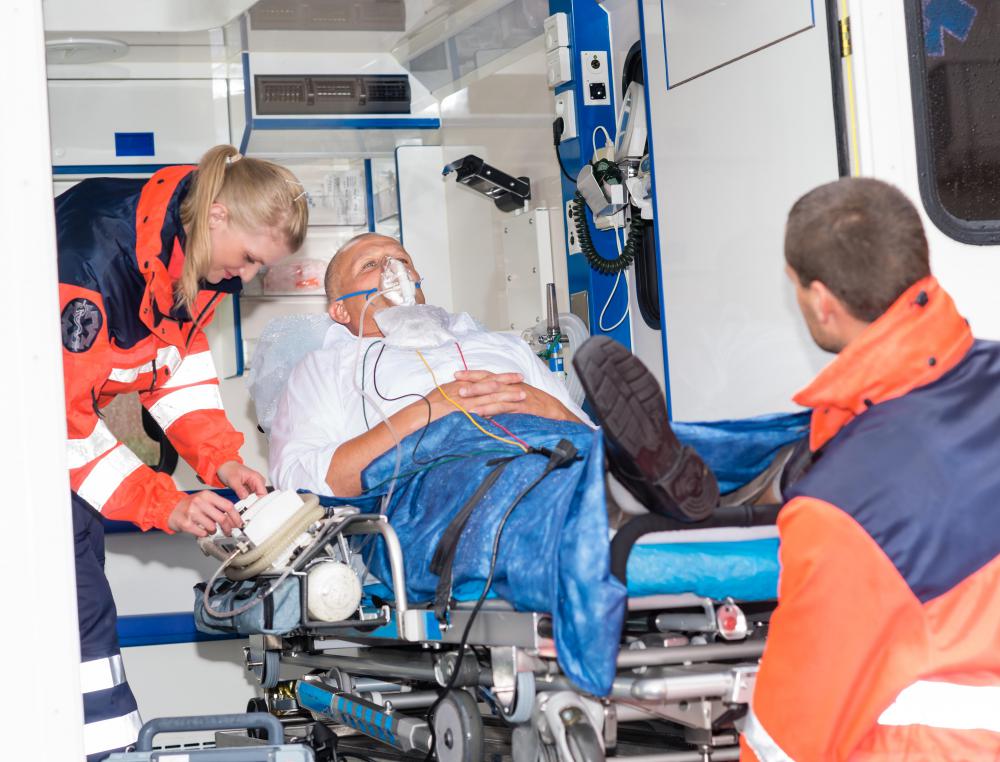At TheHealthBoard, we're committed to delivering accurate, trustworthy information. Our expert-authored content is rigorously fact-checked and sourced from credible authorities. Discover how we uphold the highest standards in providing you with reliable knowledge.
What is Defibrillation?
Defibrillation is a medical treatment used for people experiencing life-threatening cardiac arrhythmias where the heart is shocked to encourage normal rhythm to return. It is used in patients who have ventricular fibrillation or pulseless ventricular tachycardia, both caused by problems with the area of the heart that controls contractions of the ventricles. Emergency medical personnel are trained to use this treatment as early as possible in cases where it may be effective and the development of automatic defibrillators has allowed lay people to provide this form of medical aid in emergencies as well.
In defibrillation, the heart is subjected to a sharp electrical shock, causing the heart muscle to depolarize and stopping an arrhythmia. When the heart repolarizes, the natural pacemaker can reassert itself, and the heart will return to normal rhythm. If the shock is too small, the heart can fall back into arrhythmia. Likewise, some arrhythmias will return because they are caused by a chronic condition that cannot be corrected with defibrillation. Administered properly, defibrillation can save lives.

While medical dramas often show medical personnel shocking patients in asystole, where there is no heartbeat at all, defibrillation is actually only suitable for patients who have specific types of abnormal rhythm. If a patient has no pulse and is nonresponsive and appears to have a ventricular arrhythmia, this treatment is suitable. If the patient has no heartbeat, shocking the heart will not help. This technique can also be used with certain other types of cardiac arrhythmias, in which case it is known as cardioversion, not debfibrillation.

Several different kinds of devices can be used to shock the heart into a normal rhythm. Many are portable so they can be carried on ambulances or loaded on a crash cart, a medical cart with an assortment of supplies used in responding to an emergency in a clinical or hospital setting. Some devices have electrodes that must be held in place, while others come with pads to attach to the patient and clip to leads. Internal defibrillators can be implanted in patients with a history of arrhythmias, providing a shock to the heart from inside the body when an arrhythmia is detected.

In locations where automatic external defibrillators (AEDs) are available for lay use, people should follow the directions on such advices very carefully. A patient should not be shocked if a pulse is present or the patient is responding to communication. If trained personnel are on hand, it is advisable to turn AED use over to them because they have been familiarized with the device.
AS FEATURED ON:
AS FEATURED ON:















Discussion Comments
@pleonasm - Frankly, the public has a really skewed image of how these machines work. On TV they always show defibrillation as something that's done to get the heart started again. However, they aren't used like that in real life. They are used to get the heart to work properly by giving it a flat line so it can restart itself.
If the problem is that there is already a flat line, there's nothing a defibrillator can do and there are other things that need to be tried (like CPR and medications). I'd hate for an ordinary person who doesn't understand this to be able to just grab a public AED defibrillator and use it without any instruction.
@pastanaga - I don't think that's possible. I think most of the time (if not all the time) there is a defibrillator available to the public, it's an AED (Automatic External Defibrillator). We were told about them in a first aid course I took recently.
They don't work at your commands, they basically do all the diagnosis themselves. So you can't just thrust them at someone and say "clear". They need to be hooked up to the person so that the machine can tell what kind of shock they need (if any) and then it delivers it.
Any other kind of machine that's in public will be one that only a registered person (likely an employee) can use.
I'm a writer, so I guess my mind always automatically goes to a bad place, but I can't help but wonder if these public machines have ever been used in a bad way. I don't mean misused with good intentions, perhaps on someone who seemed like they were having a heart attack, but weren't really, but misused by someone with a malicious intent.
I could see a teenager thinking it would be funny to give someone a shock. I mean, maybe they could even be used in self defense, if someone is being attacked and they can use the external defibrillator like a weapon to defend themselves.
Post your comments